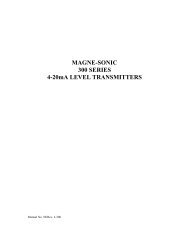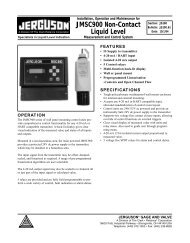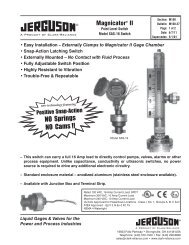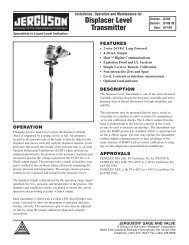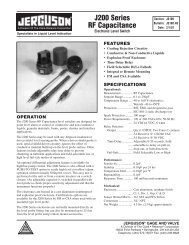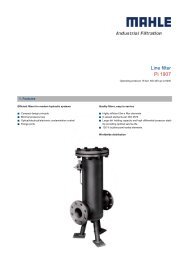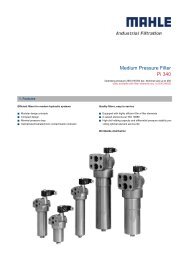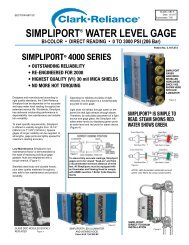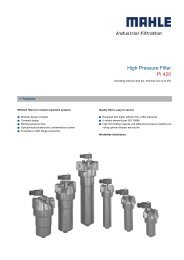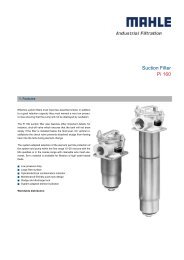Top Mount Displacer Operated Level Switch - Clark Reliance
Top Mount Displacer Operated Level Switch - Clark Reliance
Top Mount Displacer Operated Level Switch - Clark Reliance
- No tags were found...
You also want an ePaper? Increase the reach of your titles
YUMPU automatically turns print PDFs into web optimized ePapers that Google loves.
Installation, Operation and Maintenance Instructions • <strong>Top</strong> <strong>Mount</strong> <strong>Displacer</strong> <strong>Operated</strong> Magnetic <strong>Level</strong> <strong>Switch</strong>JERGUSON LEVEL SWITCHESTHE SWITCH MECHANISMPrinciple of OperationThe switch mechanism is based on a unique three-dimensional magnet designwhere the snap action is accomplished by the utilization of magnetic repulsion.The magnet mounted on the float road causes the secondary magnet torotate as it passes up and down. The switch magnet is repelled by the secondaryand snaps to the opposite side. This causes the cradle to pivot, moving thepush rods which operated the switch contacts. The result is positive snapaction interlock switching…no springs…no spring problems.Schematic showing three-magnet systemChoice of <strong>Switch</strong> MechanismsTypeApplicationX4, X8 General purpose – 10 amp mechanisms for general purpose duties up to 480°FD4, D8 High temperature – 750°F mechanisms for high temperature applications up to5 ampsH4, H8 Hermetically sealed – Suitable for low temperature duties, contaminated atmosphereenvironments and intrinsically safe circuits. All moving parts and contactsenclosed in an inert gas filled stainless steel enclosure.P4, P8 Low current – Gold-plated contact switch mechanism for use in intrinsically safeor low power circuits up to 750°F4 Contact Type D4, X4, P4, H42 x S.P.S.T.AA Make on RiseBB Make on FallLink for SPDT/SPCO8 Contact Type D8, X8, P8, H8D.P.D.T.4 x S.P.S.T.AA Make on RiseBB Make on FallLink for DPDT/DPCOPRINCIPLE OF OPERATIONThe displacer element, made of either stainlesssteel or ceramic depending upon the application,is suspended on a stainless steel cable from aspring. The displacer element is always heavierthan its equivalent volume of the liquid in whichit is to operate, and therefore will extend the tensionspring at all times. Hanging freely, thespring will extend to a known length, controlledby a mechanical stop to prevent overstressing.Attached to the spring is the rod and magnetassembly, which is free to move up and downwithin the pressure tube as the spring extends orcontracts, actuating the switch mechanism.As rising liquid submerges the displacer, a buoyancy force is created equal to theweight of the displaced liquid volume. This force reduces the apparent weight of thedisplacer, contracting the spring and moving it upwards inside the pressure tube,actuating the switch mechanism. On a falling liquid level, the displacer element isuncovered and the spring senses an increasing effective weight, extending the spring.The increased effective weight moves the magnet to re-set the switch mechanism.This simple principle can berefined to operate a single switchover a very wide differential byproviding the buoyancy forcefrom two displacer elementsinstead of a single one.Two switch models are availablefor two applications with two narrowdifferentials for pump controlwith appropriate wide differentials.In all cases, because the elementsare suspended on a cable, switchingor control levels may be manyfeet below the mounting flange,and are fully field adjustable tore-setting the displacer elementson the cable.



